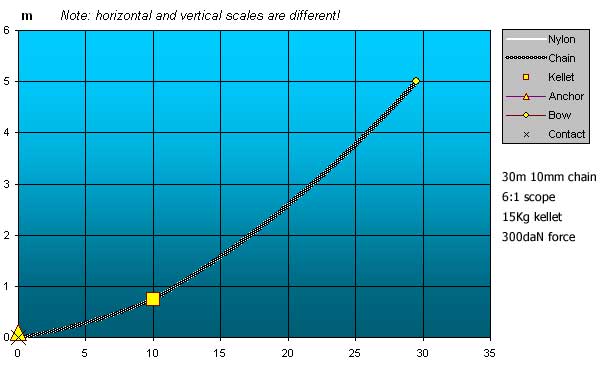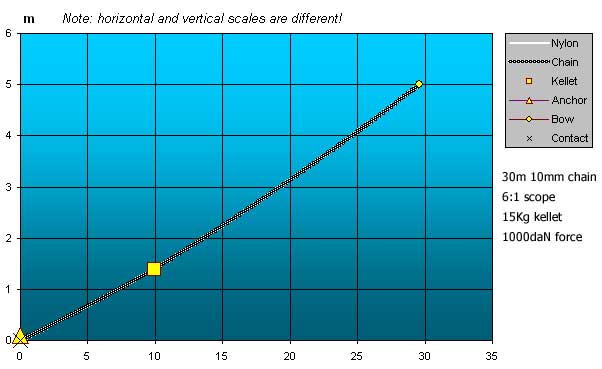Kellets, also known as anchor angels, sentinels, or buddies, are frequently hailed as a way in which to increase the holding power of your anchor, reduce dragging incidents, and complement the rest of your ground tackle. Along with the idea that catenary from chain drastically improves holding power, there is a misconception that an anchor kellet will make a large difference to the performance of the anchor. In fact, the uses for which they are best suited lie elsewhere.
Performance
A proper discussion of weight in the ground tackle as it impacts on performance is complex. Please refer to the separate article on this topic “Catenary & Scope In Anchor Rode”. However, the general claim of an anchor kellet is that it improves the performance of the anchor by reducing the angle of pull on it. It is true that the minimization of this angle is desirable, and it is also true that any weight in the rode will have some effect on lowering it. Unfortunately, concluding that the kellet is therefore effective is fallacious, as the true effect is a very relative thing.
To illustrate the true effect of a kellet, computer simulations courtesy of Alain Fraysse will be employed. The graphs below give a visual picture of the profile of the anchor rode in specific circumstances.
The kellet will be given every chance to prove itself. We will imagine a 12 m (∼40′) boat, and simulate a 15 kg (33 lb) kellet weight. This is much heavier than would be typical. (Nb. no account of true weight underwater is made; the kellet as simulated in fact weighs this figure when submerged, so its true mass must in fact be greater!). We will use a conservative 6:1 scope, and the rest of the ground tackle will consist of 10 mm chain.
Firstly, we will apply a virtual 300 daN (≈ 300 kgf or 675 lb-force) to our system. For our typical 12 m yacht, this would correspond to the peak loads experienced during 25–30 knots of wind with some surge generated by fetch.

It can already be seen that the kellet has little effect. Were the angle being drastically reduced, one would expect to see a sharp increase in the slope of the chain immediately behind the kellet. However, while there is some benefit, it is not great.
Now, we will apply a more serious load of 1,000 daN to the same system. This sort of load is roughly approximate to 50 knots of wind on our 12 m yacht, again with accompanying surge. Naturally these sorts of conditions are the true test of any anchoring system, a test that should be passed easily.

It should be clear that the rode is practically bar taut. Neither catenary nor the kellet is having any significant impact on the angle of pull on the anchor.
Context
On a 12 m boat a 20 kg (44 lb) or 15 kg (33 lb) anchor might be used. Considering the Rocna 15 (33 lb) and other similar sized new generation anchors have been proven to hold well in excess of 1000 daN at less scope than this scenario, it should be clear the kellet is a waste of time in the pure context of anchor performance – even when it’s the same weight as the anchor itself!
The fallacy of a special case
Proponents – particularly commercial ones – of kellets commonly try to demonstrate the effectiveness of a weight on the rode by computing the forces required to completely lift the rode off the seabed (so that the angle being exerted on the anchor is non-zero). Physical demonstrations may also be seen, where someone is asked to manually lift and pull taut first a rope, then chain, then chain with a kellet. Predictably it is much more difficult to straighten the line with the kellet attached, the angle of pull on the anchor is visibly lower, and the ‘test’ is proudly claimed as proving that anchor holding power is improved as a consequence.
However, this is a non sequitur. The effect of course is real, and if the holding power of the anchor was measured to be similar to this magnitude of force, the claims would hold true. But, fortunately, any good anchor even in poor holding seabeds will be able to sustain far higher forces that will lift the rode well off the seabed and create a significantly positive angle of pull.
In other words, this argument is a fallacy of context. It considers the case of the rode being lifted off the seabed as a special case, but it is not. On the contrary, is perfectly common for anchors to sustain loads that see their chain pulled bar taut (nearly straight), and good anchors are designed to withstand the resulting lift force. As illustrated above, forces of these magnitudes in the rode mean that a kellet cannot appreciably lower the angle of pull, and therefore the ultimate holding capacity of the anchor is not improved by it to any significant degree.
Increasing holding power
The intent of kellets is to lower the angle of pull on the anchor, to as close to horizontal (or 0° relative to the seabed) as possible. As discussed above, this is not realistic for a weight on the rode in any scenario likely to test the anchor. The rules of geometry however cannot be argued with, so increasing scope remains as the only sure way to get closer to this goal. A scope of 3:1 gives a maximum angle of pull on the anchor of 19.5°; 5:1 gives 11.5°, and 7:1 gives 8.2°. (Rode length must be doubled to halve this maximum angle, so increases beyond 7:1 or 8:1 require very large increases to achieve improvements of only a few degrees.)
Consider also how much benefit is achieved by upping the size of the anchor. An extreme example is in the idea of re-allocating the weight in the simulations above – what if the weight from the 15 kg kellet was instead put into the anchor itself? A 30 kg or 35 kg anchor would result, for no increase in the total weight of the system – yet the holding power would be nearly doubled.
The reality is: if an increase in an existing anchoring system’s ultimate holding capacity is required for all scenarios, the only way it may be achieved is by using a more efficient anchor type, or increasing the size of that type, in order to improve the grip on the seabed.
This is not intended as a general recommendation to maximize your anchor’s size no matter what – the anchor must be sensibly sized for its boat by separate consideration. Indeed, because of the low magnitude of its effect on performance, the presence or absence of a kellet should have no bearing on anchor sizing.
Other applications
This is not to say that kellets are entirely pointless; they serve other purposes.
- They can contain and minimize swing radii in light conditions
- They can help dampen “sailing” at anchor
- They can keep a boat stationary when using bow and stern anchors
- They can help ensure that rode is kept down and away from the boat’s keel, rudder, and propeller.
The ideal placement of the kellet is different according to the application. This is an unfortunate fact, as it means the desired benefit must be selected – the best of all worlds cannot be had.
To achieve the supposed increased anchor performance already dismissed, the kellet should be placed as close to the anchor as possible. This is so its weight exerts the maximum leverage on the rode. It pays to note that a kellet is not a point on a graph, but a physical object which hangs below the rode. Therefore, it cannot be placed directly next to the anchor, otherwise it will simply rest on the bottom and its weight will have no effect.
To provide the best shock absorption, the kellet should be placed halfway along the rode. (Shock absorption is a point not elaborated on above, as it is closely related to the idea of increasing anchor performance). Since one may wish to both increase one’s holding power and benefit from shock absorption, one could compromise and place the kellet one quarter along the rode from the anchor. Neither is ideal, as, like the lowered pull angle, this quasi “spring” disappears in bad conditions when it is most needed.
To minimize swinging radius, the kellet should be positioned down the rode from the boat a distance equal to that of the vertical distance to the seabed (depth plus height to bow-roller). This allows the kellet to remove as much slack from the rode as possible in light conditions. (Nb. while effective in light conditions, this technique is questionable in any case; if the anchorage is empty, swing radius is unlikely to be important, whereas if it is crowded, it is desirable to swing similarly with the other boats).
Conclusion
Kellets are curious accessories that unfortunately are frequently misused. Sales talk from companies promising “increased anchor performance” is misleading at best. Kellets do little to improve the effective holding power of the anchor.
